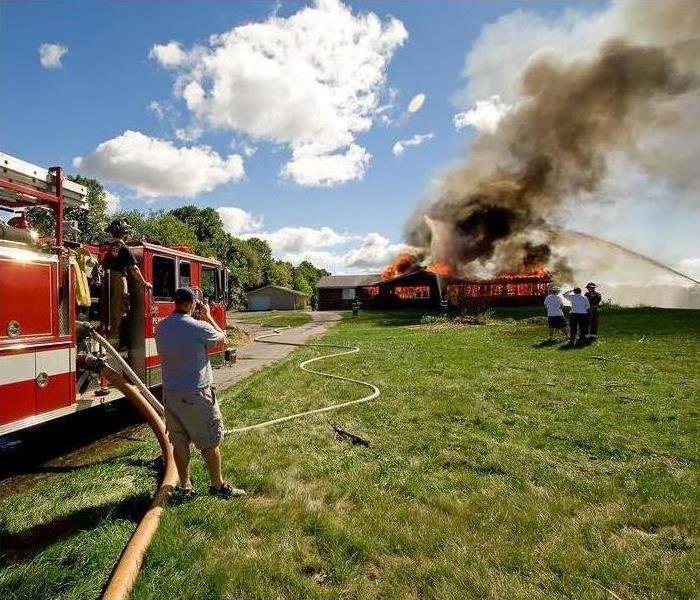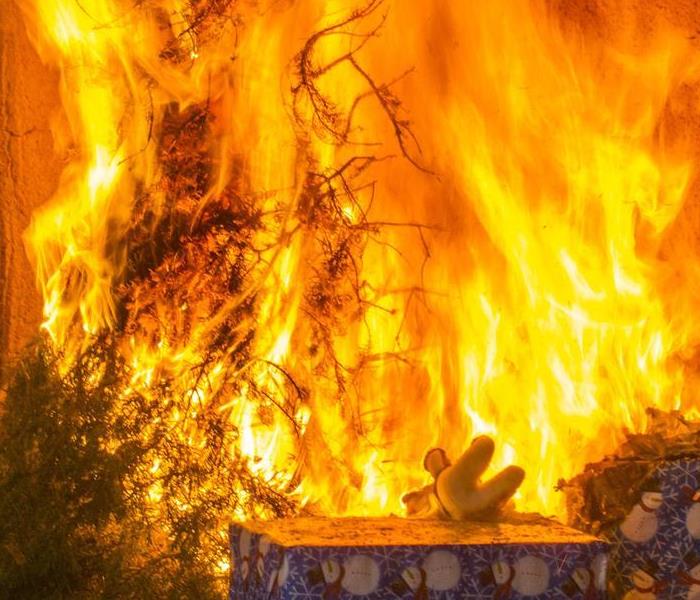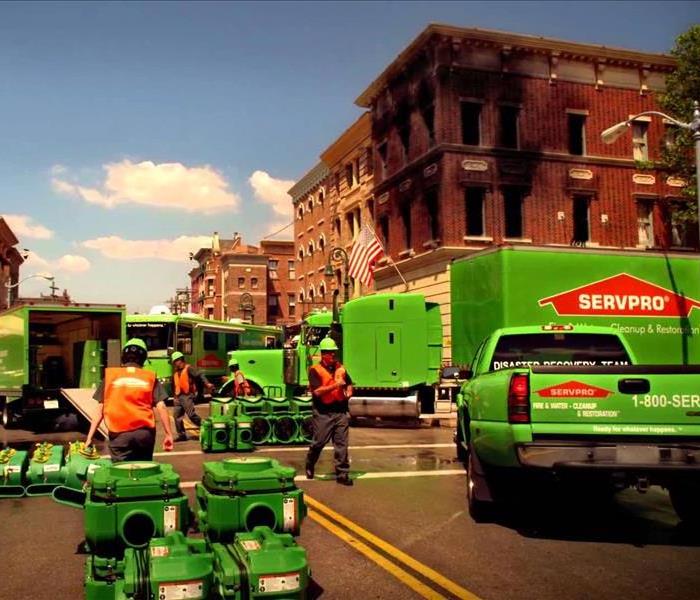Archived Fire Damage Blog Posts
Protect Your Home and Loved Ones | SERVPRO of Cookeville/Carthage/Smithville/Woodbury
8/12/2024 (Permalink)
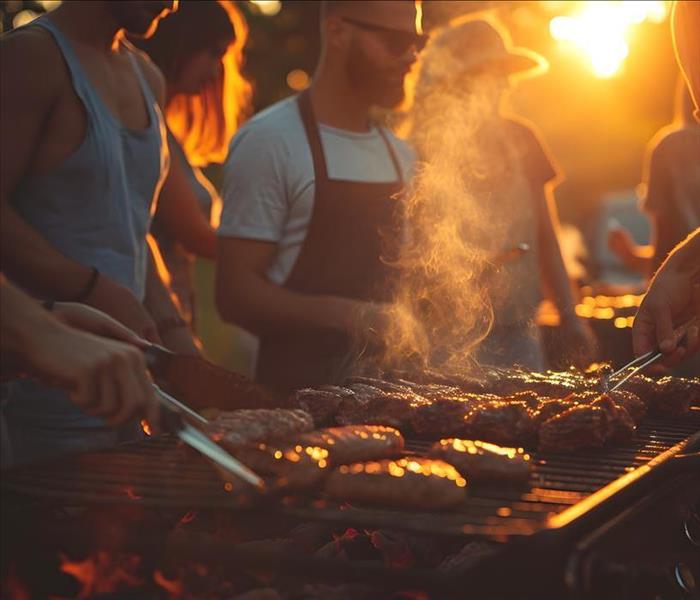 Follow these fire safety tips from SERVPRO of Cookeville/Carthage/Smithville/Woodbury for a safe summer!
Follow these fire safety tips from SERVPRO of Cookeville/Carthage/Smithville/Woodbury for a safe summer!
Summer is a time for fun and relaxation, but it's also a season when fire risks can increase. Whether you're enjoying a barbecue, camping, or simply spending time outdoors, it's important to take precautions to keep your home and family safe from fire hazards. At SERVPRO of Cookeville/Carthage/Smithville/Woodbury, we're here to help you with some practical tips for summer fire safety.
Keep Your Barbecue Safe
Barbecues are a summer favorite, but they can also be a fire hazard if not used properly. Here are some tips to ensure your grilling activities are safe:
1. Position Your Grill Wisely: Place your grill at least 10 feet away from your home, deck railings, and overhanging branches.
2. Check for Gas Leaks: Before using a gas grill, inspect the hose for leaks by applying a light soap and water solution. If you see bubbles, repair the leak before using the grill.
3. Never Leave Your Grill Unattended: Always stay close to your grill when it's in use, and keep a fire extinguisher or a bucket of sand nearby just in case any flames get out of control.
Campfire Safety
Camping is another beloved summer activity, but campfires can be dangerous if not handled correctly. Follow these guidelines to enjoy a safe and fun camping trip:
1. Choose the Right Spot: Build your campfire at least 15 feet away from tents, shrubs, and trees.
2. Prepare the Area: Clear away dry leaves and other flammable materials within a 10-foot radius of the campfire.
3. Keep Water Nearby: Always have a bucket of water or a shovel and dirt close to the campfire to extinguish it quickly if needed.
4. Never Leave a Campfire Unattended: Make sure the fire is completely out before leaving the area. Douse it with water and stir the ashes until they are cold.
Be Cautious with Fireworks
Fireworks are a staple of summer celebrations, but they pose significant fire risks. To enjoy fireworks safely, it is best to catch a professional show. If you do choose to use sparklers or other small fireworks at home, keep this rules in mind:
1. Follow Local Laws: Only use fireworks that are legal in your area.
2. Supervise Children: Never allow children to handle fireworks.
3. Keep Water Handy: Always have a hose or bucket of water nearby in case of fire.
4. Dispose of Fireworks Safely: Soak used fireworks in water before disposing of them in a metal trash can.
Maintain Your Home’s Exterior
During the summer, it's also important to maintain your home's exterior to reduce fire risks:
1. Clean Gutters and Roof: Remove dry leaves and debris from your gutters and roof to prevent them from catching fire.
2. Trim Vegetation: Keep trees and shrubs trimmed and away from your home.
3. Store Flammable Materials Safely: Keep propane tanks, gasoline, and other flammable materials in a safe, well-ventilated area away from your home.
By following these summer fire safety tips, you can enjoy the season while keeping your home and loved ones safe.
For more information or assistance with fire damage restoration, contact SERVPRO of Cookeville/Carthage/Smithville/Woodbury today!
The Basics of Cooking Fire Safety | SERVPRO of Cookeville/Carthage/Smithville/Woodbury
8/7/2023 (Permalink)
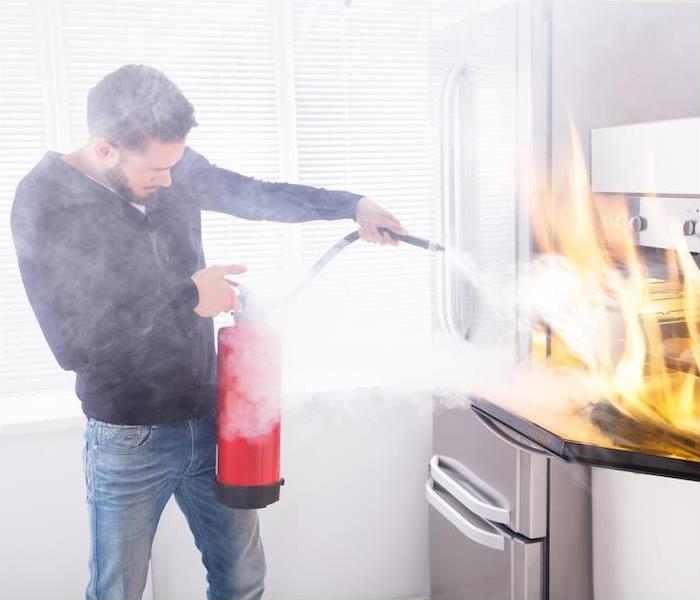 Has your kitchen suffered from a fire? SERVPRO of Cookeville/Carthage/Smithville/Woodbury is "Here to Help" get you back to preloss condition.
Has your kitchen suffered from a fire? SERVPRO of Cookeville/Carthage/Smithville/Woodbury is "Here to Help" get you back to preloss condition.
Have you ever noticed how the kitchen quickly becomes the heart of the home? Even if yours is small, it seems like everyone ends up gathering in the kitchen to chat, snack or share a little dance party.
The kitchen is also one of the leading locations for home fires. Cooking can lead to a number of disasters, sometimes even resulting in the loss of home or life. Taking the meal prep outdoors can be just as dangerous.
The good news is that most house fires that result from cooking accidents can be prevented. Get used to making safety a priority while you cook—and keep your home safe.
Safety Indoors
Even when you hope they don’t, your family and guests you entertain in your home will inevitably end up standing around the stove while you prepare meals or snacks. Take some steps to make your kitchen safe at all times:
Make sure there is a working smoke detector near the kitchen, and never leave a hot stove unattended. Get to know how to extinguish the kinds of fires that might start in the kitchen, including grease fires.
Keep a fire extinguisher nearby, but never throw water on a grease fire. If something catches on fire in the oven, turn it off and leave the door closed until the flames ease.
The best way to stay safe is to stay vigilant. Takeout is a better option when you are just too worn-out to get a home-cooked meal on the table. In the same light, if you are home alone with the kiddos, make sure they are somewhere close enough to keep an eye on them and what you are cooking, or opt to cook when they are otherwise supervised.
Safety Outdoors
Cooking outdoors is a great way to avoid heating up your house on hot days, or just to spend a little time outside. Grill fires are another leading cause of house fires, though, and they are almost always from misuse.
Make sure your grill is in an open space with plenty of distance from any other structures. Like with the stove and oven in the kitchen, never leave a hot grill unattended.
Teach the kiddos and your four-legged friends how far away to stay while you are cooking. Check gas lines or propane tanks for leaks or loose parts before operating them, and only use approved charcoal and lighter fluids.
Cooking can be one of the most enjoyable parts of your day. We all have to eat after all! Make your home safe while you cook to avoid potential fires.
Had a fire in your home and need restoration? Contact us to get things put back together fast!
How Do You Put Out a Grease Fire?
7/29/2022 (Permalink)
According to the National Fire Protection Association, cooking fires are the leading cause of home fires and home injuries. A grease fire happens when the oil or fat gets too hot, starts to boil, smokes, and catches fire. The smoking point of vegetable oils is around 450 degrees Fahrenheit; for animal fats, it’s about 375 degrees F.
Prevent cooking accidents by:
- Staying in the kitchen when using the stove
- Removing moisture from food before frying
- Never dropping frozen food in hot oil
- Heating the oil to the recommended temperature
- Having a lid handy in case the oil catches fire
- Keeping kids and pets away from the oven while cooking
Follow These Steps If You Have a Grease Fire
Step 1
If the blaze is contained in a pot or pan, cover the flames with a metal lid or baking sheet. If you still see fire, pour baking powder or salt on the area to smother it. Don’t use flour, baking powder, or biscuit mix as they’re flammable and will aggravate the problem.
Step 2
Turn off the burner if you can do so safely. Don’t try to move the pan; the motion can make the flames stronger. For a fire in a microwave or oven, don’t open the door. Turn the appliance off and call 911.
Step 3
Use a dry chemical fire extinguisher as a last resort. Use the PASS method: pull, aim, squeeze, and sweep. Don’t use water to put out the blaze. When it hits the hot pan, the water will turn to steam, which will spread the oil and the fire.
If you can’t put out the fire, evacuate your home and call 911. Stay at a safe distance and don’t go back in until directed by the firefighters.
A grease fire can do more than ruin your meal. If you find damage in your Upper Cumberland, home, and need whelp with fire cleanup, get in touch with a local fire damage restoration company.
4 Candle Alternatives for Fire Safety
7/29/2022 (Permalink)
Here are Four Fire-Safe Candle Alternatives
Candles are used to create decorative lighting effects or release fragrances. Whether you are looking for safer mood lighting or a way to diffuse a scent without any risk of a candle fire, here are four fire-safe candle alternatives.
1. Battery-Powered Candles
A flameless electric alternative to candles can be placed anywhere for decorative or lighting purposes. Electric candles come in a wide variety of colors, heights, thicknesses and designs. Some battery-powered models are also designed to release fragrances.
2. Strings of Lights
Another way to get a candle-lit look is to string up Christmas or fairy lights. Strings of lights are designed with fire safety in mind. Choose from strands of single-color or multicolor bulbs. It is also possible to set up lights to blink or flicker if desired. Ultra-efficient LED bulbs make replacements affordable and keep energy costs low.
3. Candle Warmers
A candle warmer may be the best option among these candle alternatives for fans of scented candles. A warmer makes it possible to enjoy these fragrances with a much lower fire risk. A warmer may be a base on which a candle sits or resemble a lamp.
4. Diffusers
Reed diffusers do not resemble candles. For a different look, reeds in oil can be an attractive, creative and flameless way to release a scent. Diffusers have an even lower risk of fire than an electric candle warmer.
Most candle fires occur around the holidays. Battery-powered candle alternatives and strings of lights are safer options for illuminated decorations. Warmers and diffusers are useful for spreading a fragrance throughout a home with a lower risk of fire. If a fire starts due to a candle or any other cause, you should attempt to extinguish the flames or contact the fire department. Fire damage restoration experts can restore or replace damaged building materials at a residence in the Upper Cumberland.
How to Respond to a House Fire: The Most Effective Strategies
6/30/2022 (Permalink)
It's that time of year again - fire season. As the weather gets hotter and drier, the risk of house fires goes up. A fire can start from any number of sources: a faulty wire, an overloaded outlet, a kitchen accident, or a bonfire left unattended. If your home catches fire, it's important to know how to respond quickly and effectively. In this blog post, we will discuss the most effective strategies for responding to a house fire. Stay safe!
If a Fire Starts, Here Is What You Need To Know:
The first line of defense against a fire is to know how to safely use the right fire extinguisher for a house fire. This simple step can save lives and tens of thousands in property damages. If the fire loses control, immediately get out and stay out, then call 9-1-1. Leave all your things where they are and save yourself.
If your clothing catches on fire, remember the old phrase: Stop, Drop, and Roll.
If you live in a building with elevators, it is important to use the stairs in case of a fire. A fire can short out the elevator electrical system, and the shaft can act like a chimney and rapidly fill up with dangerous smoke.
Understanding how to use doors to your advantage during a fire can mean the difference between life and death. If the door or handle is warm, do not open it. If you can't escape through the primary way, find another way out. Do not open any doors that are warm to the touch.
If some, heat, or flames block your exits, close any doors around you, place a wet towel under the doors and call the fire department or 9-1-1. Tell them exactly where you are so they know where to find you.
If you're near a window that you can't use as an escape, open it and wave a brightly colored cloth or use your phone flashlight to signal for help.
What To Do After a Fire
After a fire, it is important to contact a professional fire damage restoration company like SERVPRO of Cookeville. We have the training, experience, and equipment to properly restore your home - "Like it never even happened."
If you try to clean up the fire damage yourself, you could end up making the situation worse both in your home and with your insurance company's process.
Trust the experts, and call today!
Lightning and Risk of Fire to Your Home
6/30/2022 (Permalink)
Lightning and Risk of Fire to Your Home
Lightning is one of the most dangerous natural forces in the world, and this phenomenon has the ability to cause significant damage to the homes that it strikes. One of the major hazards that it poses is the threat of lighting fire to your residence. If you are a homeowner in the Upper Cumberland read on for more information about electrical storms and the potential risks to your property.
How Does It Enter Your Home?
A bolt of lightning will always find the quickest path to enter the ground, and unfortunately, homes can sometimes be part of that path. Your home can be entered a number of ways.
- Direct strikes
- Power, cable or phone lines
- Electrical gates or doors
- Metal pipes
How Do Fires Start?
Once a strike occurs, the risk of a house fire is considerable. A bolt is a current of electricity that can reach temperatures comparable with the surface of the sun. The intense heat is enough to ignite a flame, especially in highly flammable parts of the home, such as the attic or within the walls where insulation is present. Electrical charges can also create dangerous sparks responsible for lighting fire to homes and buildings.
Stay Safe During Storms
Remember, you are within striking distance if you can hear thunder. During storms, stay inside, away from doors and windows, and avoid using items that place you in contact with plumbing or electricity. If your home suffers a strike, contact the fire department to check over your property. If you detect smoke, call 911 and evacuate everyone from the premises immediately.
Electrical storms and strikes can form quickly and wreak havoc in your life by lighting fire to your home. If your dwelling is a victim of this type of blaze, don’t hesitate to reach out to an emergency restoration service to assist you.
What To Do After Smoke Damage
9/1/2021 (Permalink)
Dealing with the cleanup that comes post-fire damage is devastating enough, but what about handling the soot and smoke smell afterward? Often, it’s true that scents can bring back emotional memories, and the smoke damage is sure to conjure up some traumatic ones. That’s why, at SERVPRO of Cookeville, we specialize in deodorization and odor removal so that you can start the restoration process post-disaster.
What Are Some Ways SERVPRO of Cookeville Can Eliminate Smoke Odors?
- Our experienced team is trained to identify and eradicate offensive odors as a result of smoke damage. These odors are known to come from sources beyond the interior of your home in the Upper Cumberland.
- We have the training and equipment required to detect these odors, thereby eliminating them soon afterward. Our technicians have access to numerous odor removal products capable of penetrating through carpets, upholstery, and surfaces to neutralize the smell completely.
- We also teach IICRC technical courses in proper odor removal. We know that just going surface level won’t be enough to thoroughly eliminate smoke odors, especially if those odors are severe or persistent. In other words, we know better than to take shortcuts!
How Can I Recover Important Documents And Precious Photographs After Smoke Damage?
We handle all documents and photographs with extreme care to ensure that fire/smoke damage doesn’t ruin the items further. Although some documents may be beyond saving, SERVPRO of Cookeville can still save many of your documents and help reduce further damage.
There are five options for document/photograph drying, depending on the level of smoke, soot, and fire damage. These options are:
- Vacuum Thermal Drying
- Vacuum Freeze Drying
- Air Dehumidification
- Freezer Drying
- Air Drying
Smoke damage to your home in the Upper Cumberland as a byproduct of fire damage doesn’t have to turn your life upside down. However, with our expertise in this field and our prompt response time, you can get your life back to normal in no time! Don’t hesitate to call SERVPRO of Cookeville today at 931-528-9292. This franchise is independently owned and operated.
Dangers Of Fire Damage
9/1/2021 (Permalink)
When not properly addressed and taken care of, fire damage in Cookeville, or any other place in the Upper Cumberland, can spell disaster for a building’s structural integrity as well as the general health and well-being of the building’s occupants. After a fire, there are several necessary steps that must be taken during the fire damage restoration process to restore buildings to their original conditions and ensure the health and safety of everyone who enters them.
So, what are some of the dangers of fire damage in the Upper Cumberland?
- Fire damage can leave your building full of soot, which when inhaled, can cause or exacerbate serious conditions like lung cancer, asthma, and more.
- Heat can severely weaken or damage concrete, wood, and other structural materials that often make up the commercial and residential buildings. Your building should always be assessed post-fire damage to check for structural damage before you or anyone else enters it again.
- Permanent fire damage can also impact the buildings adjacent to where the fire took place. Depending on how far the fire and smoke spread, others buildings nearby may not be safe or need to be restored, too.
How can you restore fire damage?
Here at SERVPRO of Cookeville, our fire damage restoration process consists of the following steps.
Step 1: Emergency Contact
The restoration process begins when you call 931-528-9292.
Step 2: Inspection and Fire Damage Assessment
We carefully inspect and test the adjoining rooms of your property to determine the extent of the damage.
Step 3: Immediate Board-Up and Roof-Tarp Service
We can board up missing windows and walls and place tarps on damaged roofs to prevent further damage.
Step 4: Water Removal and Drying (if water damage is present)
If water is present, the removal process begins almost immediately.
Step 5: Removal of Smoke and Soot from All Surfaces
Specialized equipment and techniques help remove smoke and soot from ceilings, walls, and other surfaces.
Step 6: Cleaning and Sanitizing
Next up comes cleaning, sanitization, and disinfecting.
Step 7: Restoration
Restoration is the final step to restore the building to its pre-fire condition.
You can contact SERVPRO of Cookeville for fire damage restoration or other disaster restoration services by calling 931-528-9292. This franchise is independently owned and operated.
3 Tips for Preventing a Space Heater Fire
6/10/2021 (Permalink)
Does your home in Cookeville have a space heater? Being responsible for more than 40% of heater fires, a burned space heater is a common culprit that many fire cleanup specialists see often. There are many easy ways to stay safe with one of these fixtures in your home.
1. Leave Space
It's called a space heater because it's designed to heat space, not your curtains. In addition to keeping your heater away from any fabrics or other flammables, be sure to inform your children about the dangers of leaving objects near them. Plastic toys melt if left close by a heater for a long time. If you have pets, take steps to ensure that they won't knock over the heater or otherwise harm themselves accidentally.
2. Keep It Clean
Another common cause of a burned space heater is a clogged filter. Though not all units come with one, it's important to clean it regularly if yours does. Different cleaning measures are recommended based on the manufacturer's instructions. If you lost your manual, check online for a pdf of it or look on your unit for a phone number to call. No matter what, be sure that you never clean your filter with any type of alcohol or scented aerosol spray as both are extremely flammable. The smoke cleanup from that is a hassle that you don't want to deal with.
3. Set a Timer
We all forget things every once in a while, but it's important that you don't forget to turn off your space heater. While some units come with a timer, most don't. If yours doesn't, try setting a timer on your phone, microwave, or oven. Additionally, if your home has a smart assistant, consider using wall plug accessories to automatically shut off your unit.
With some knowledge, it's certain that your home won't be affected by a burned space heater anytime soon.
What Is Content Cleaning?
6/10/2021 (Permalink)
Clothing and other items that have been damaged, but not destroyed, due to a fire can sometimes be restored by dry-cleaning and other methods to remove soot and smoke smells. This process is called content cleaning.
What Types of Contents Can Be Cleaned?
Contents are classified as either hard or soft. Soft contents include items made from fabric and other soft materials:
- Clothing
- Leather goods
- Bedding
- Uniforms
- Heirlooms
Hard contents include items such as furniture, electronics, collectibles, sports equipment and antiques. Whether the item is hard or soft and what type of material is its made from affects the cleaning method utilized.
Cleaning Methods
Content restoration professionals use different types of cleaning methods for different types of contents. Dry-cleaning is often used to remove light residues or pre-clean clothing. Wet cleaning can be used to remove heavy residues. Spray and wipe methods are used on items that may be damaged by wet cleaning. Foam cleaning is used for upholstery fabrics. Abrasive cleaning is used on some hard surfaces and immersion cleaning is used for contents that can be submerged in cleaning products.
Contents Analysis
After you contact a fire restoration company in Cookeville, to perform content cleaning, a team member will examine your property and determine which items are salvageable. Unsalvageable items need to be replaced.
Pack Up, Pack Out and Pack Back
If extensive restoration is needed, the restoration company can pack up and move your damaged items to their facility for cleaning. The items are then packed out and cleaned. The clean items are kept in content storage until they are ready to be packed back and delivered to the homeowner.
Dry-cleaning and other cleaning methods can be used by fire restoration professionals to restore some items damaged by fires. A content cleaning team in your area can assess the salvageability of your contents and save you money by restoring some items that would otherwise need to be replaced.
5 Safety Tips To Avoid Chimney Fire Damage
6/7/2021 (Permalink)
Chimney fire damage can be prevented
Chimney fires are a lot more common than most people realize since most chimney fires aren't "full-on" fires that burst out from the top of the chimney and burn the house down. Tiny chimney fires are the most common; they start and then go out on their own but typically result in a damaging cycle for your chimney.
This blog post will discuss how many chimney fires start in the Upper Cumberland and provide prevention tips to avoid unwanted fire disasters.
How do chimney fires start?
It's far too common for chimney fires to start when debris (nests and leaves) and creosote buildup within the chimney. Burning unseasoned wood, a limited air supply (like failing to open the damper), lower than average chimney temperatures, overloading the firebox are all conditions that promote creosote buildup.
Signs of a dirty chimney
- The fireplace emits a strong odor of burned wood when not in use.
- Poorly burning fires causing a lot of smoke in the home.
- A black chimney damper. The damper is typically located directly above the firebox.
5 Safety tips to avoid chimney fire damage
1) Keep the chimney clean
Keeping your chimney clean is the easiest way to avoid chimney fire damage. Burning wood produces creosote, a hazardous and easily flammable byproduct. Creosote buildup on the interior walls of the chimney causes the majority of home chimney fires. Creosote may appear like tar-like texture or crusty and hard.
2) Use fireplace doors and a screen
Before starting a fire, it is best to have both a door and screen installed. Doors and screens will help prevent smoke, hot embers, and carbon monoxide from entering your home.
3) Burn suitable materials
Professional chimney cleanings will clear the fireplace flue of flammable creosote. However, by burning "clean" flames, you can help keep creosote from forming in the first place. Use seasoned wood that has been drying for at least six months and has a low moisture content.
4) Keep the damper open
When you're lighting a fire in your fireplace, leave the damper wide open to minimize creosote buildup.
5) Install a chimney cap
When loose embers move higher up the flue, debris such as leaves or bird nests may catch fire. Install a chimney cap to prevent unwanted materials from entering the chimney flue.
The chimney cap will also prevent "back puffing," which occurs when escaping smoke re-enters the chimney and then your home.
Lastly, a chimney cap will reduce moisture from entering your home. Water in your chimney can destroy the dampers, liners, and also mortar joints of your chimney. Keep in mind that chimney mold growth is common when there is excess water.
Why are annual inspections so important?
A previous chimney fire, particularly one that went unnoticed, may cause severe damage to your chimney system as well as your home. A damaged or melted roof, heat damage to your walls, ceilings, or structural beams near the chimney are all possible areas for fire damage.
The most damaging outcome of a chimney fire is that it opens paths for carbon monoxide to enter the house and removes the protections that shield the home from future fires. A stray spark or second chimney fire could quickly lead to a house fire if the previous damage is not correctly repaired. So, with that being said, it's always wise to get an annual inspection done to ensure your chimney is ready to be put into use.
Call SERVPRO for chimney fire damage cleanup.
The professionals at SERVPRO get many calls a year regarding house fires caused by a chimney. When you call SERVPRO of Cookeville, a certified professional will come out and inspect the cause of the chimney fire damage so you can ensure that it doesn't happen again. Following a thorough inspection, we will then perform mitigation and restoration services to clean up and repair the fire damage “Like it never even happened.”
SERVPRO of Cookeville / Carthage / Smithville / Woodbury is locally owned and operated, so we’re already close by and ready to respond immediately when you need us. We’re also part of a national network of over 1,700 Franchises, which gives us access to more resources for larger cleaning or restoration projects or major storm scenarios. Our team is fully equipped with state-of-the-art tools and has years of experience in cleaning after smoke damage and restoring chimney fire damage. We offer 24/7 emergency services to our customers, so feel free to contact us anytime!
What are Soot Webs After Fire Damages?
6/7/2021 (Permalink)
Soot webs are also known as black cobwebs
A fire event in your house or property can be wild and unforgiving, causing unimaginable destruction. Not only does such an incident affect you emotionally and financially, but it also causes hidden damages such as lingering smoke damage and dark-colored soot webs hanging on walls- putting the health of your property at risk. Although these damages might not be as visible and noticeable, they might cause harm equivalent to the fire itself.
SERVPRO is a reputable restoration company providing smoke and soot damage restoration services with its IICRC trained technicians and over-the-edge technology - to reinstate your property back to its original functional preloss shape in a relatively short time!
The aftermath, including smoke and soot released from the fire, can also cause the property to deteriorate and collapse. As soon as our 24/7 emergency restoration team reaches on-site, we inspect the site and perform several other tests to investigate any likely threats for future damages.
Our fire mitigation services include removing damaged components, or in this case, black cobwebs - using modern tools and suitable chemicals, evaluating property’s structural framing, clean up and deodorizing using odor counteractants - to help you with faster recovery with our efficient, prompt, and par excellence services!
What are soot webs?
We are often called up by our customers complaining of black spider webs in their post-fire-damaged properties, regardless of their weekly cleaning routine. While they sheepishly mistake it for their inadequate cleaning skills, being completely oblivious of the actual reason behind it.
During a fire, the burning of synthetic or petroleum-based material such as plastic, form, wood products, or paper can result in soot webs. The charged soot particles released from these sources stick together to make long chains of ionized soot, resulting in a web-like-structure known as black cobwebs. They are usually found on the ceilings and in the room corners due to low circulation in these areas.
The build-up heat in a fire advances towards the structure’s cold places as the air seeks to attain atmospheric equilibrium. Thus the heat soot particles are carried away through the air towards the cold regions, where they concentrate - becoming soot webs. These smoke web structures are undoubtedly new, and as commonly perceived, they are not formed as a result of soot sticking to the cobwebs already existing before the fire outbreak.
How do you clean soot webs?
If, unfortunately, you find soot webs in your house or business property, never try to get rid of it on your own. Specialized training and machinery are necessary for cleaning soot webs. Cleaning soot webs on your own may lead to secondary damage and further trouble!
Depending upon the fire outbreak's nature, we strive to provide you with a solution well-suited to your restoration needs. SERVPRO, having years of experience in fire damage restoration, with its certified and efficient technicians and up-to-date tools and technology, assures to professionally assist you in removing smoke damage on walls!
While it's always good to educate yourself regarding precautionary methods to avoid getting yourself into any inconvenience; however, if you are caught in this unforeseen situation, do not panic; contact us right away.
Maintaining Your Fire Sprinkler System
7/30/2020 (Permalink)
Maintaining Your Fire Sprinkler System
As a commercial business owner or property manager, you’ve made long-term investments for both yourself and your employees. Keeping those assets safe from the real possibility of fire requires taking the time and effort to inspect and maintain the mechanics of your business’s fire sprinkler system. NFPA 25 is the Standard for the Inspection, Testing and Maintenance of Water-Based Fire Protection Systems, and it should be referred to, along with codes and regulations specific to your location in the Upper Cumberland. Additionally, you should keep in mind the following items.
1. Keep Maintenance Dates Handy
When your sprinkler system is installed, a tag is attached displaying in detail the inspection, test and maintenance service performed. A new tag will be attached each time a service has been completed. Although the tag confirms dates of service, have a calendar within reach to remind you of the scheduling of future inspections and tests. Having a backup means fewer chances of receiving violations and costly penalty charges for forgetting to maintain your sprinklers.
2. Be Aware of Hazards
Always keep an eye out for all possible fire hazards, in addition to whatever objects could prevent the fire sprinkler system from working properly. Avoid placing tall objects beneath sprinklers to ensure water is distributed evenly throughout the space. A room packed to capacity could impede the sprinkler head and essentially cause more fire damage.
3. Enlist Professionals To Clean Up After Sprinkler Use
It’s a given that a sprinkler system is used to put out fires, but the system itself could cause water damage to the premises, not only to furniture, fabrics, and equipment, but also beneath the surface if left untreated. A water damage restoration specialist can help to clean up the aftermath if your system is ever engaged.
The state fire marshal’s office, local fire departments, and certified fire sprinkler contractors are available to answer any questions you might have concerning the maintenance and use of your sprinkler or fire suppression system. Be proactive. Maintain, test, and inspect your sprinkler system according to the codes and standards as directed.
How To Prevent a Dryer Fire
7/30/2020 (Permalink)
Many appliances in your home that you use on a daily basis can result in a home fire in the Upper Cumberland, if broken or not maintained correctly, including your clothes dryer. While a fire damage cleanup company can help if this situation does arise, there are several important steps for preventing a lint fire in your home.
Have Your Dryer Professionally Installed and Maintained
Having a professional technician install your dryer and service it at least twice a year is a great start to making sure your dryer is set up to perform optimally. There are many areas of your dryer where lint can cause dangerous blockages, and a technician can check if any repairs are necessary.
Fully Remove Lint
Many people know that they are supposed to clean the lint filter after they do a load, but not everyone is aware they should also clean out their vent pipes regularly to prevent a lint fire. Make sure to never neglect cleaning the lint filter before starting a new load and clean the inside your dryer from any remaining lint. If you feel your dryer is getting too hot or there is no air escaping from the dryer vent, clean the air exhaust vent pipe from all lint and debris.
Practice Good Habits
When doing laundry, be aware of potential fire hazards that can result in a dryer fire. Keep flammable objects off the surface of the appliance and avoid overloading your dryer. It is also a good idea to never do laundry when you’re asleep or away so you can address an issue right away.
While you might assume that your dryer will always work as it should, a lint fire can happen with improper maintenance. Make sure to get the help of a professional when needed and try to remove as much lint as possible from your dryer in between cleanings.
2 Fire Causes Not Covered By Insurance
5/29/2020 (Permalink)
Two Types of Fires that Are Not Covered By Insurance
Homeowner's insurance covers the majority of home fire causes. The main exceptions are houses that are vacant, such as vacation homes, or intentional fires. An insurance policy should also shield the named insured and other residents from liability unless there is any proof of arson. Find out more about the two types of fires that are not covered perils and how to increase the overall level of protection from fire risks at a residence in the Upper Cumberland.
1. Vacant Home Fire
The terms of most standard homeowners policies define a residence that has not been occupied for 30 consecutive days as vacant. A vacant home endorsement, rider or a separate policy will be necessary to cover any type of fire that breaks out in this structure. Vacancy policies may be added to a primary property policy as an endorsement or rider or be obtained in the form of a supplementary policy. This coverage will apply during any periods of time in which the residence is vacant.
2. Arson
A deliberate home fire is not covered by any insurance policy. Starting a fire may be related to an attempt to commit insurance fraud, damage property or endanger the residents of a home. If an investigation discovers evidence of an intentional fire, criminal charges may be brought against the named insured or another party. Penalties may range from mischief all the way up to a misdemeanor or felony. Aggravated or first-degree arson can result in a prison sentence of up to 25 years or longer.
Owners of vacation homes should maintain vacancy coverage. It is also a good idea to confirm the extent of home fire liability protection on a standard homeowners policy. No coverage will apply to intentional fires. If a fire damages building materials and contents at a residence in the Upper Cumberland, the owner should contact cleanup and restoration professionals.
Choose SERVPRO to Clean Smoke Damage after a Fire
5/19/2020 (Permalink)
When the firefighters leave, it may seem like the danger has passed and the home is safe from further destruction, but without SERVPRO professionals to help clean the smoke damage, the building will never return to normal.
While fire is always the immediate danger, once it is gone, what it leaves behind will continue to affect the house. Ash and smoke, if left unhindered, will cause extensive corrosion, etching and discoloration, not to mention lingering powerful odors. Calling SERVPRO to clean fire and smoke damage can stop this before it becomes a major problem, assuming they are contacted soon enough.
SERVPRO can clean smoke damage and restore items affected by a fire, but they must be brought to the site as soon as possible to halt the ongoing issues that ash residue can cause. The first thing that ash does to the home is discolor most surfaces. Anything that is made of plastic or was close to the fire will start discoloring within minutes, and within several hours, fiberglass and finishes on appliances will begin to yellow. Metals may also tarnish. After a few days pass, the ash will cause walls to discolor permanently, along with clothing and upholstery. Wood and vinyl will need to be refinished or replaced, and metal will start corroding.
If SERVPRO isn’t hired to clean smoke and fire damage, the costs for restoration will skyrocket after a few weeks. Metals may need to be replaced, carpet will permanently discolor and glass may be severely etched, which will necessitate replacement. It will also become apparent that the odors caused by the disaster may still be present and intense enough to be distracting. Because ash is acidic, the longer it takes to hire experts, the more destruction it will cause.
The first thing SERVPRO will do when on site is to identify all affected materials and the source of any odors. The only way to properly clean smoke and fire damage is to be extremely thorough. Ash residue is easily disturbed and can spread through the building with ease, causing nearly everything to need restoration. Our professionals will identify what can and cannot be salvaged, and will remove any built-up ash residue that is coating surfaces. Over time, ash builds up in layers, and may eventually form into a lacquer-like consistency. Once this is done, SERVPRO will locate the source of the odor, and treat it with specialized detergents that are formulated for neutralizing this kind of odor. Once materials are treated, they may be sealed off to prevent any further odor from permeating the air in the future.
This entire process is very detailed, and hiring a professional that can be trusted to do the job right is imperative. SERVPRO of Cookeville/Carthage/Smithville/Woodbury specializes in: water remediation, flood mitigation, carpet cleaning, tile and grout cleaning, mold removal, fire damage, and smoke clean up, disaster restoration, storm response, and air duct cleaning. SERVPRO of Cookeville/Carthage/Smithville/Woodbury serves the Upper Cumberland area. We are licensed and insured and have an A+ rating with the better business bureau in restoration and cleaning.
Call us for any of your cleaning or restoration needs at (931)-528-9292.
Source: http://www.IICRC.org/why-professionals-should-clean-smoke-damage-from-fire-a-38.html
What Happens After a Fire’s Flames Are Tamed?
5/19/2020 (Permalink)
When thinking of a fire’s aftermath, charred property comes to mind. However, there’s a secondary effect: Fire damage is often accompanied by water damage from the extinguishing process. Understanding how the two damage your residence is key to knowing the appropriate process for cleanup in Cookeville, TN.
Soot Doesn’t Suit Your Home
Fire leaves behind corrosive, acidic soot. This soot discolors and disfigures furnishings and flooring within hours. That is but the beginning of the problems. If left alone for even a few days more, soot’s profound consequences can be as such:
• Rusted or corroded metals
• Wall discoloration
• Permanent furniture upholstery stains
• Flooring damage that needs refinement or replacement
• Glass and china disfigurement
• Harmful airborne chemicals from burning plastics
Where There Was Smoke, There’s Water
Heat, oxygen, and fuel are needed to sustain a blaze. Water removes heat from a fire when it evaporates, so it remains a staple of modern containment protocol. When the fire department uses a fire hose, hundreds of gallons of water pour into your home. This water can become even more problematic than the fire damage alone if left to fester. Dangers associated with water damage include things such as mold, flooding, odor, and damage to flooring, walls, wires, and electronics.
Time Is Vital for Revival
Every moment that passes without treatment, the damage stands to become worse. It’s essential to start the cleanup process immediately once your home is no longer burning. Thankfully, knowledge of the potential hazards informs you of what to look for and eases the process of dealing with insurance.
On top of being urgent, cleanup of the aftermath of fire damage is not simple. If you wish to do it yourself, it’s worth noting that most people do not have cheap or easy access to the industrial machines necessary to safely and completely remove water damage or soot.
Not only does fire damage a property, but water from a fire hose can cause additional problems if not cleaned up immediately. A damage recovery service deploys experts who use professional tools and established procedures to mitigate your property’s damage.
For more information, visit http://www.SERVPROcookevillecarthagesmithvillewoodbury.com/.
The Fire Is Out. Now What?
5/4/2020 (Permalink)
We've been taught since preschool that when you see smoke or flames in your house, call 911 immediately. What homeowners need to do after the fire department leaves is less common knowledge. This is where SERVPRO of Cookeville/Carthage/Smithville/Woodbury comes in.
Speed Is Key
Within hours of the fire being out, metals tarnish, countertops yellow, and grout stains.
Within days, walls yellow, clothing stains, and circuit boards may fail due to corrosion. This is why it is important to contact your insurance to verify coverage and file a claim as soon as possible.
Once the home is released by the fire department, schedule an initial assessment with a trained and licensed fire restoration company to see what can be salvaged and develop a plan of action. After the initial assessment is complete, the home should be boarded up and the roof tarped to maintain security and protect from further damages.
Fire Mitigation
The first step in the mitigation process is to pack out and clean the contents that were affected by smoke and soot. All of the restorable contents in affected areas will be professionally cleaned and deodorized. Restoration professionals begin by carefully inspecting and testing all fabrics in the structure to determine which cleaning methods are most appropriate. They should be able provide wet or dry cleaning services. Additionally, all the other restorable contents will be cleaned and deodorized to preloss condition. Finally, restoration professionals can provide an inventory list of all “to be claimed” items if requested.
Content Inventory
Restoration professionals can generate comprehensive room-by-room inventories. Contents are categorized as salvageable, non-salvageable and questionable - allowing for easier contents settlement.
Restore VS Replace
Once the contents are out of the home, SERVPRO of Cookeville/Carthage/Smithville/Woodbury's technicians will reassess the structure for unseen damages. We will clean and disinfect structure materials that were affected, and restore the home to its pre-fire condition. This may include some repairs to the structure.
We focus on restoring versus replacing because restoring the affected areas of your property is substantially less costly than demolishing and replacing those areas. This “restore first” mentality also allows us to get your home back to pre-fire condition quicker and with less disruption.
Once the repairs are complete, the home is deodorized and the contents are moved back in "Like it never even happened."
How To Prevent a Dryer Fire
7/18/2019 (Permalink)
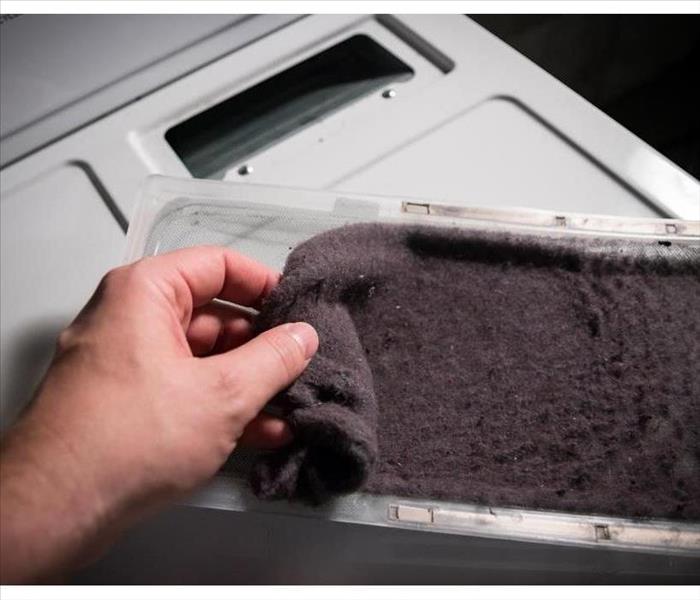 Clean the lint after every load
Clean the lint after every load
Many appliances in your home that you use on a daily basis can result in a home fire in Baxter, TN, if broken or not maintained correctly, including your clothes dryer. While a fire damage cleanup company can help if this situation does arise, there are several important steps for preventing a lint fire in your home.
Have Your Dryer Professionally Installed and Maintained
Having a professional technician install your dryer and service it at least twice a year is a great start to making sure your dryer is set up to perform optimally. There are many areas of your dryer where lint can cause dangerous blockages, and a technician can check if any repairs are necessary.
Fully Remove Lint
Many people know that they are supposed to clean the lint filter after they do a load, but not everyone is aware they should also clean out their vent pipes regularly to prevent a lint fire. Make sure to never neglect cleaning the lint filter before starting a new load and clean the inside your dryer from any remaining lint. If you feel your dryer is getting too hot or there is no air escaping from the dryer vent, clean the air exhaust vent pipe from all lint and debris.
Practice Good Habits
When doing laundry, be aware of potential fire hazards that can result in a dryer fire. Keep flammable objects off the surface of the appliance and avoid overloading your dryer. It is also a good idea to never do laundry when you’re asleep or away so you can address an issue right away.
While you might assume that your dryer will always work as it should, a lint fire can happen with improper maintenance. Make sure to get the help of a professional when needed and try to remove as much lint as possible from your dryer in between cleanings.
Maintaining Your Fire Sprinkler System
6/27/2019 (Permalink)
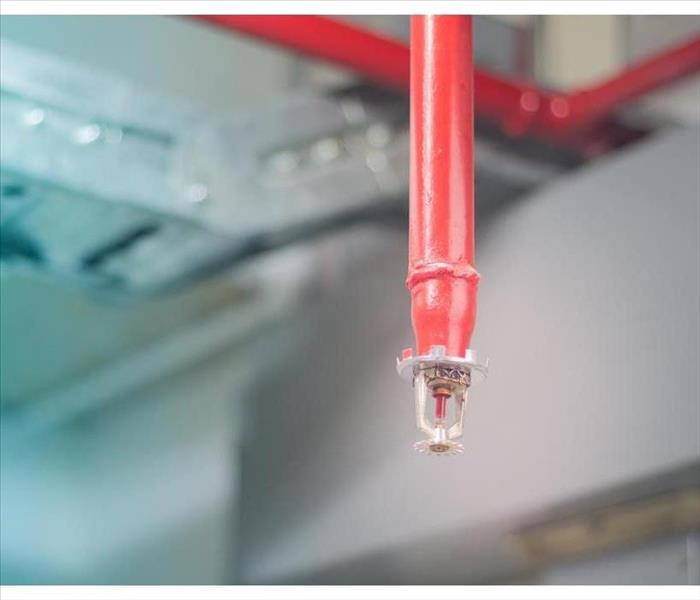 Maintain, test, and inspect your sprinkler system
Maintain, test, and inspect your sprinkler system
Maintaining Your Fire Sprinkler System
As a commercial business owner or property manager, you’ve made long-term investments for both yourself and your employees. Keeping those assets safe from the real possibility of fire requires taking the time and effort to inspect and maintain the mechanics of your business’s fire sprinkler system. NFPA 25 is the Standard for the Inspection, Testing and Maintenance of Water-Based Fire Protection Systems, and it should be referred to, along with Monterey, TN, codes and regulations. Additionally, you should keep in mind the following items.
1. Keep Maintenance Dates Handy
When your sprinkler system is installed, a tag is attached displaying in detail the inspection, test and maintenance service performed. A new tag will be attached each time a service has been completed. Although the tag confirms dates of service, have a calendar within reach to remind you of the scheduling of future inspections and tests. Having a backup means fewer chances of receiving violations and costly penalty charges for forgetting to maintain your sprinklers.
2. Be Aware of Hazards
Always keep an eye out for all possible fire hazards, in addition to whatever objects could prevent the fire sprinkler system from working properly. Avoid placing tall objects beneath sprinklers to ensure water is distributed evenly throughout the space. A room packed to capacity could impede the sprinkler head and essentially cause more fire damage.
3. Enlist Professionals To Clean Up After Sprinkler Use
It’s a given that a sprinkler system is used to put out fires, but the system itself could cause water damage to the premises, not only to furniture, fabrics, and equipment, but also beneath the surface if left untreated. A water damage restoration specialist can help to clean up the aftermath if your system is ever engaged.
The state fire marshal’s office, local fire departments, and certified fire sprinkler contractors are available to answer any questions you might have concerning the maintenance and use of your sprinkler or fire suppression system. Be proactive. Maintain, test, and inspect your sprinkler system according to the codes and standards as directed.
2 Fire Causes Not Covered By Insurance
5/20/2019 (Permalink)
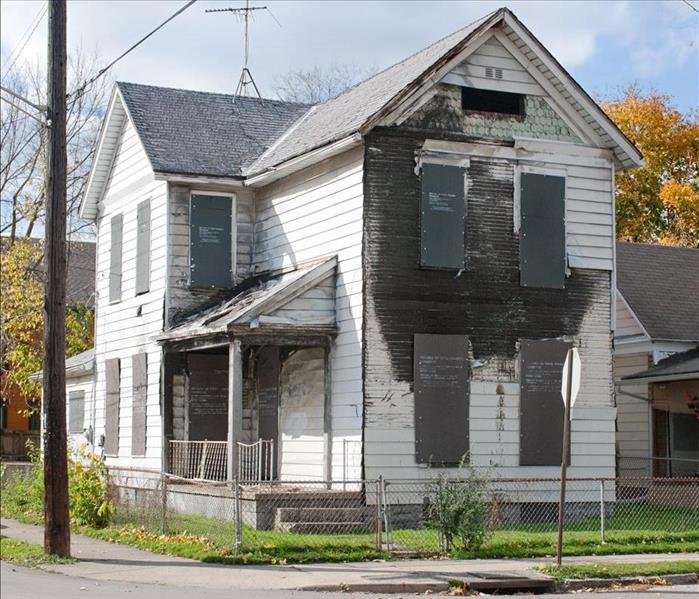 Vacant home fire in Carthage, TN
Vacant home fire in Carthage, TN
Two Types of Fires that Are Not Covered By Insurance
Homeowners insurance covers the majority of home fire causes. The main exceptions are houses that are vacant, such as vacation homes, or intentional fires. An insurance policy should also shield the named insured and other residents from liability unless there is any proof of arson. Find out more about the two types of fires that are not covered perils and how to increase the overall level of protection from fire risks at a residence in Carthage, TN.
1. Vacant Home Fire
The terms of most standard homeowners policies define a residence that has not been occupied for 30 consecutive days as vacant. A vacant home endorsement, rider or a separate policy will be necessary to cover any type of fire that breaks out in this structure. Vacancy policies may be added to a primary property policy as an endorsement or rider or be obtained in the form of a supplementary policy. This coverage will apply during any periods of time in which the residence is vacant.
2. Arson
A deliberate home fire is not covered by any insurance policy. Starting a fire may be related to an attempt to commit insurance fraud, damage property or endanger the residents of a home. If an investigation discovers evidence of an intentional fire, criminal charges may be brought against the named insured or another party. Penalties may range from mischief all the way up to a misdemeanor or felony. Aggravated or first-degree arson can result in a prison sentence of up to 25 years or longer.
Owners of vacation homes should maintain vacancy coverage. It is also a good idea to confirm the extent of home fire liability protection on a standard homeowners policy. No coverage will apply to intentional fires. If a fire damages building materials and contents at a residence in Carthage, TN, the owner should contact cleanup and restoration professionals.
The Fire Is Out. Now What?
5/4/2019 (Permalink)
We've been taught since preschool that when you see smoke or flames in your house, call 911 immediately. What homeowners need to do after the fire department leaves is less common knowledge. This is where SERVPRO of Cookeville/Carthage/Smithville/Woodbury comes in.
Speed Is Key
Within hours of the fire being out, metals tarnish, countertops yellow, and grout stains.
Within days, walls yellow, clothing stains, and circuit boards may fail due to corrosion. This is why it is important to contact your insurance to verify coverage and file a claim as soon as possible.
Once the home is released by the fire department, schedule an initial assessment with a trained and licensed fire restoration company to see what can be salvaged and develop a plan of action. After the initial assessment is complete, the home should be boarded up and the roof tarped to maintain security and protect from further damages.
Fire Mitigation
The first step in the mitigation process is to pack out and clean the contents that were affected by smoke and soot. All of the restorable contents in affected areas will be professionally cleaned and deodorized. Restoration professionals begin by carefully inspecting and testing all fabrics in the structure to determine which cleaning methods are most appropriate. They should be able provide wet or dry cleaning services. Additionally, all the other restorable contents will be cleaned and deodorized to preloss condition. Finally, restoration professionals can provide an inventory list of all “to be claimed” items if requested.
Content Inventory
Restoration professionals can generate comprehensive room-by-room inventories. Contents are categorized as salvageable, non-salvageable and questionable - allowing for easier contents settlement.
Restore VS Replace
Once the contents are out of the home, SERVPRO of Cookeville/Carthage/Smithville/Woodbury's technicians will reassess the structure for unseen damages. We will clean and disinfect structure materials that were affected, and restore the home to its pre-fire condition. This may include some repairs to the structure.
We focus on restoring versus replacing because restoring the affected areas of your property is substantially less costly than demolishing and replacing those areas. This “restore first” mentality also allows us to get your home back to pre-fire condition quicker and with less disruption.
Once the repairs are complete, the home is deodorized and the contents are moved back in "Like it never even happened."
4 Key Points Regarding Home Fires and Insurance Coverage
2/4/2019 (Permalink)
 Ask your insurance agent if you are covered
Ask your insurance agent if you are covered
Home Fires And Insurance Coverage
A home fire can severely damage or even destroy your property. Fortunately, most homeowner’s insurance policies cover fire damage, helping to reduce out-of-pocket restoration costs. Because coverage varies, it’s important to familiarize yourself with specific policy details, exclusions and additional options that may provide enhanced protection.
1. Common Insurance Coverage
When it comes to fires, insurance typically covers costs associated with repairing or rebuilding the dwelling as well as replacing damaged possessions. If your home is temporarily uninhabitable, many policies also provide additional living expenses to fund interim housing.
2. Liability Protection
Liability protection is another common component of many policies. Possessing this coverage can be important, especially if someone is injured at your residence or the actions of a household member spark the home fire.
3. Vacant Home Fires
Some residents of Carthage, TN , may own dwellings that are vacant for a portion of the year. While the exact definition varies, a residence is often deemed vacant if it’s unoccupied for more than 30 consecutive days. If you own a vacation home, this distinction can be important because your insurance provider may deny a claim if it can prove the incident was a vacant home fire.
To safeguard your investment and financial security, you should discuss your options with an insurance representative. You may be able to include an endorsement on your current coverage or purchase vacant home insurance.
4. Arson
Intentionally setting a residence on fire is a crime that nullifies insurance coverage. To combat fraud and rule out arson, your provider will likely investigate the cause of any reported inferno. Suspicious behavior, such as increasing coverage or making several expensive purchases, prior to the blaze may also cause your provider to question and possibly deny your claim.
A devastating home fire is a potential threat that many homeowners fear. Recognizing exclusions and ensuring you have adequate coverage for every property you own can spare you from costly out-of-pocket expenses, providing some peace of mind.
Helpful Hints to Minimize Fire Risks While Cooking
12/18/2018 (Permalink)
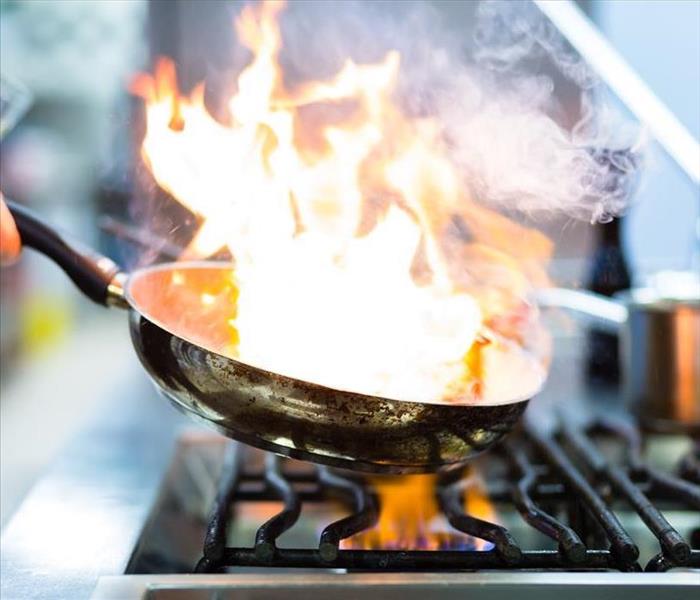 Don’t overfill your pans with oil when you cook on the stove
Don’t overfill your pans with oil when you cook on the stove
Of all the rooms in your home where you gather and spend time, the kitchen may be the most popular. Not only do you prepare and eat meals here, but it’s a common place to visit with one another and with visitors. It shouldn’t surprise anyone to know that fires occur here often. Many of these mishaps start due to poor cooking techniques or simply not paying attention while at the stove or oven. Here are some tips to help avoid fires from starting in your Carthage, TN, kitchen.
Make Sure Your Appliances Are in Tip-Top Shape
You no doubt use your stove, oven and other kitchen appliances frequently. Over time, like anything else, they’ll begin to falter. Faulty appliances are a big cause for fire damage. Make sure they are working properly and efficiently.
- Have a trained professional service your oven and stove if you detect any issues.
- Service your appliances if they are more than 10 years old.
- Clean your appliances, including the toaster, regularly.
Be Careful With Grease
If you enjoy frying foods, you probably use some type of cooking oil. While this can help concoct some delicious meals, it can also lead to a grease fire. Don’t overfill your pans with oil when you cook on the stove. Also, make sure you promptly clean up any cooking oil spills.
Don’t Walk Away
It’s easy to let ringing phones, television shows, knocks on the door or needy children distract you. However, don’t ever leave your food unattended on the stove. Heat can build up quickly and can ignite and catch fire nearby. Of all the tips to help prevent fires
Watch out for Towels
People typically hang towels near the oven or stove. If you do this, make sure they are far enough away that they don’t pose a hazard.
If you have to call in an expert to clean up after a fire, there are trained professionals who can help. However, if you are aware of these tips, you can keep your kitchen and home free of fire concerns.
Fire Safety: Understanding the Main Types of Smoke Detectors
10/23/2018 (Permalink)
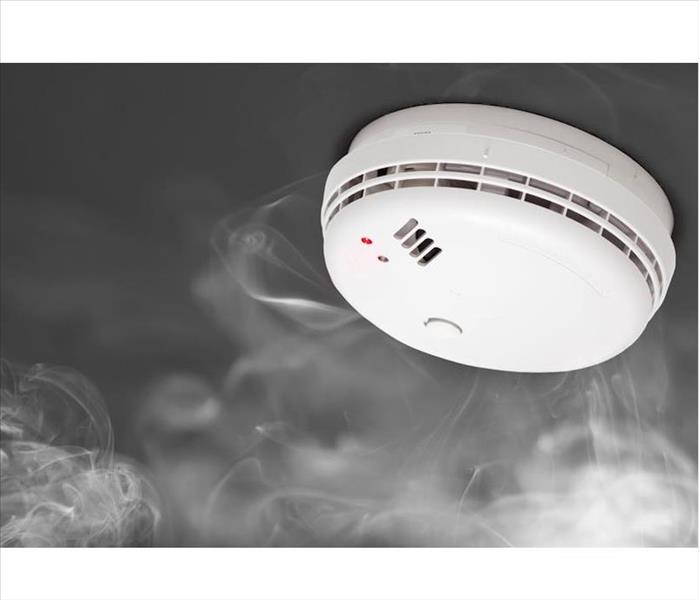 Purchase your smoke detector at Smithville,TN
Purchase your smoke detector at Smithville,TN
A smoke alarm sounds like a simple enough purchase, but when you get to the store, you are confronted with several models and terms like photoelectric, ionization and dual sensor. What does any of that mean? Well, keep reading to find out.
1. Photoelectric Alarms
A photoelectric smoke detector may be best known for its accuracy and durability. These alarms utilize a small strobe light within the housing, and when smoke enters the covering, the light is reflected toward an internal sensor that triggers the alarm. These detectors have less false alarms than ionization models because the deflection requires larger smoke particles, like those created in electrical or other common house fires.
2. Ionization Alarms
An ionization smoke alarm works by electrifying the air that enters the chamber, and when smoke enters the housing, the current is interrupted causing the alarm to sound. Unfortunately, these alarms are triggered by smaller smoke particles, meaning that false alarms do occur, especially in areas like kitchens.
3. Dual-Sensor Alarms
A dual-sensor alarm is precisely as it sounds, it is a combination of both the photoelectric and ionization alarms, making it one of the best devices for smoke detection. Unfortunately, the increased performance also comes with an increased priced tag.
4. Beyond Alarms
Many consider fire safety a significant part of home and family safety, but it goes beyond the purchase of smoke detectors. A safety plan should include evacuation routes and regular family safety meetings. Additionally, it doesn’t hurt to hire a company in Smithville,TN, that specializes in emergency planning to help you prepare for a worst-case scenario.
While it seems like a simple tool, every smoke alarm has specifications that make it useful for only certain types of situations. A photoelectric alarm is best suited for dense, slow-burning fires while an ionization alarm is designed for quicker moving fires, like grease and paper. A dual-sensor alarm may be your best choice of alarm, but the price is more. No matter your decision, just know that preparation and detection can be critical to your safety.
How To Protect Your Building After a Fire
8/28/2018 (Permalink)
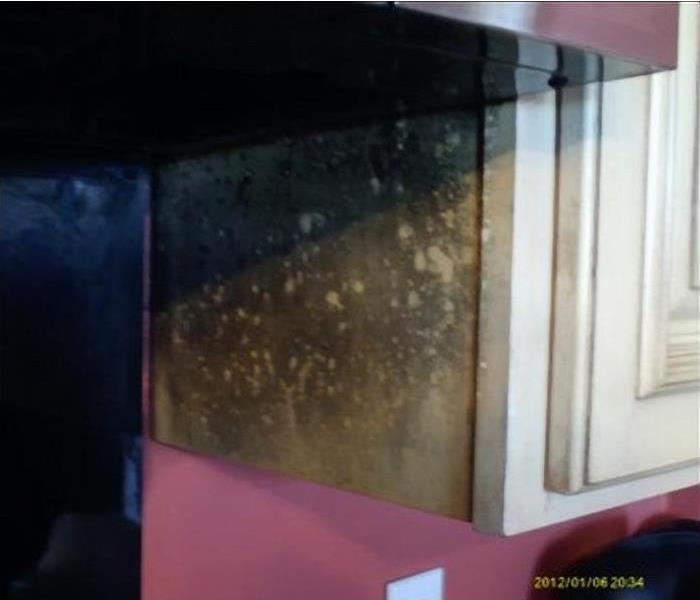 Fire damage in a Woodbury, TN home
Fire damage in a Woodbury, TN home
Even immediately after a building fire, you realize that the structure and content of your building may be damaged by fire, heat or smoke. Sometimes firefighters use a ventilation technique to help put out a fire. That sounds pretty harmless, but it really means they break through the roof, walls or windows of your building during the firefight. This necessary technique helps firefighters to:
- Remove smoke
- Release heat
- Improve vision for firefighter safety
- Increase the speed at which the fire can be put out
If your building in Woodbury, TN has fire damage to exterior walls or the roof, or if firefighters had to break through the exterior, you will need to cover these areas to protect your property from weather and exposure.
Protection From the Elements
It’s important that you hire the right remediation company to ensure the best recovery during fire cleanup. Proper recovery specialists will begin immediately by protecting your building and its contents from the elements. Here are some ways your building might need additional protection during mitigation:
- Tarp Services. Tarps are usually placed on the building to protect from water damage until roof repair is complete.
- Boarding Up. This method is used to close off the building walls and windows to keep people out for safety or to guard against theft.
- Fencing. Effective to keep people at a safe distance from the building during cleanup and construction.
These barriers protect property for you and your clients for the duration of the recovery process. This ensures that the contents and structure will not be further damaged by rain, wind, or humans.
Recovery Assistance
The many steps involved in fire cleanup can be overwhelming, but it doesn’t have to be. A professional company is efficient in handling all the steps while guiding you through the process. They are experienced and knowledgeable about proper cleaning methods with a focus on recovering items that can be saved so you can get back to work as quickly as possible.
3 Ways To Incorporate Smart Home Fire Protection
7/25/2018 (Permalink)
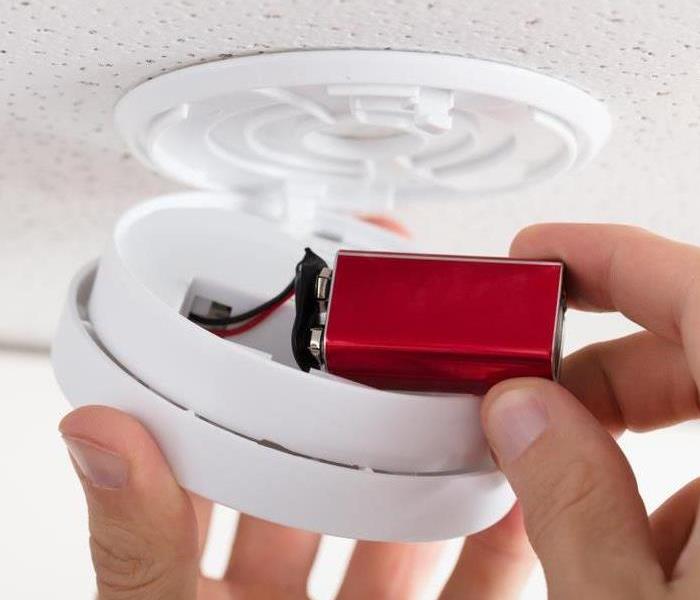 Fire safety in the home is all about preventative measures.
Fire safety in the home is all about preventative measures.
The National Fire Protection Association has long held the minimum standards for smoke alarm quota within the home, often requiring at least one per floor and one in every sleeping area. Yet, with the expansion of average home sizes and an increase of flammable materials within the household, the question of fire safety has become one of smarts.
The potential of the devastating effects and extensive restoration process of a house fire may prompt you to incorporate smart smoke alarm technology in your Cookeville, TN, home. Here are three options to consider:
1. Smart Batteries
These function in the same way as regular smoke detector batteries, with the added feature of Wi-Fi connectivity. This smart capability can send an alert to your phone when the smoke detector sounds and when the five-year battery is running low. Most smoke detectors have an average lifespan of ten years, making smart batteries a simple adaptation to the system you already have in place.
2. Listeners
If you have a larger home, a listener device could save you the hassle of routinely replacing the numerous smoke detectors within your residence. These devices plug into the wall and listen for the specific frequency of smoke alarms, sending your phone a notification if the frequency is detected. One listener device can cover upwards of an entire floor, making it an excellent connectivity tool for large homes.
3. Smart Smoke Detectors
The most comprehensive option of the three, this system would replace your current devices with internet-connected versions. Many versions include app access on your phone, allowing you to silence false alarms via push notification. Furthermore, the system can alert you when batteries are running low, effectively avoiding the notorious chirping of a traditional smoke alarm.
Fire safety in the home is all about preventative measures. Utilizing smart home fire protection technology to advance the system you already have in place provides numerous benefits. For more information, visit http://www.SERVPROcookevillecarthagesmithvillewoodbury.com/.
What Happens After a Fire’s Flames Are Tamed
5/8/2018 (Permalink)
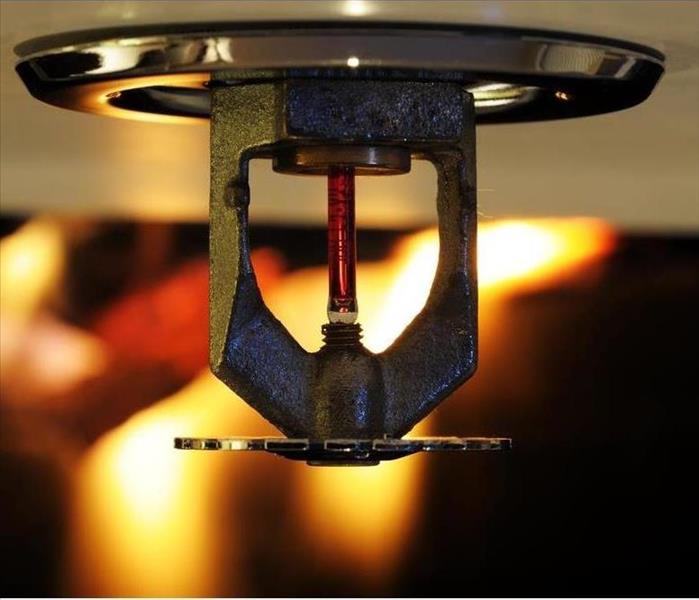 Not only does fire damage a property, but water from a fire hose can cause additional problems if not cleaned up immediately.
Not only does fire damage a property, but water from a fire hose can cause additional problems if not cleaned up immediately.
When thinking of a fire’s aftermath, charred property comes to mind. However, there’s a secondary effect: Fire damage is often accompanied by water damage from the extinguishing process. Understanding how the two damage your residence is key to knowing the appropriate process for cleanup in Cookeville, TN.
Soot Doesn’t Suit Your Home
Fire leaves behind corrosive, acidic soot. This soot discolors and disfigures furnishings and flooring within hours. That is but the beginning of the problems. If left alone for even a few days more, soot’s profound consequences can be as such:
• Rusted or corroded metals
• Wall discoloration
• Permanent furniture upholstery stains
• Flooring damage that needs refinement or replacement
• Glass and china disfigurement
• Harmful airborne chemicals from burning plastics
Where There Once Was Smoke, There’s Water
Heat, oxygen, and fuel are needed to sustain a blaze. Water removes heat from a fire when it evaporates, so it remains a staple of modern containment protocol. When the fire department uses a fire hose, hundreds of gallons of water pour into your home. This water can become even more problematic than the fire damage alone if left to fester. Dangers associated with water damage include things such as mold, flooding, odor, and damage to flooring, walls, wires, and electronics.
Time Is Vital for Revival
Every moment that passes without treatment, the damage stands to become worse. It’s essential to start the cleanup process immediately once your home is no longer burning. Thankfully, knowledge of the potential hazards informs you of what to look for and eases the process of dealing with insurance.
On top of being urgent, cleanup of the aftermath of fire damage is not simple. If you wish to do it yourself, it’s worth noting that most people do not have cheap or easy access to the industrial machines necessary to safely and completely remove water damage or soot.
Not only does fire damage a property, but water from a fire hose can cause additional problems if not cleaned up immediately. A damage recovery service deploys experts who use professional tools and established procedures to mitigate your property’s damage. For more information, visit http://www.SERVPROcookevillecarthagesmithvillewoodbury.com/.
The Battleground for Christmas
12/16/2015 (Permalink)
In the early 1900's, insurance companies wanted to stifle the Christmas season. That's not much of an exaggeration, but they had good intentions.
In the middle of the 1600's people started lighting up their Christmas trees. Of course no one had our modern electric lights then, so they would place candles, held by wax, on the end of the branches. They learned very early on this was extremely dangerous, but electric strands weren't to be invented until the late 19th century.
In 1882, an associate of Thomas Edison hand wired a strand of 80 red, white and blue lights for his personal Christmas tree. He placed his tree in his New York apartment window for all to see. The demand for these stringed lights went up and they were being mass produced in 1890. Let me clarify though, the demand went up among the extremely wealthy of the time. One strand of lights cost $300 in today's currency, including the fee for the electrician that had to install them. Since the price was so high people were still using candles well into the 20th century.
Unsurprisingly, candle-lit trees brought grief to insurance companies who increasingly had to deal with the claims relating to the tree fires. So many disastrous fires occured, newspapers would report the season's first fire as casually as the first snow fall. And the damage didn't discriminate against people. One unlucky Santa Clause caught fire while reaching to grab a present under the tree at a department store. He was burned, but lucky.
In 1908, a group of insurance companies collectively refused to pay for fires started by Christmas trees with candles. They adopted a clause of "knowing risks" in their policies. This clause was inserted mainly because a fire was practically inevitable when lit candles were placed on dry trees. This meant that department store windows illuminating with Christmas joy was banned. Church sanctuaries swelling with pines and firs were banned. Halls decked with boughs of holly were forbidden--as long as they wanted to keep their insurance policy.
Electric lights offered an alternative. However, they weren't much more reliable for safety. The next year the insurance underwriters added 'electric lights' to their list of banned decorations. Not until the 1920's were safer lights available. However Christmas tree fires were still common. In 1943, Bing Crosby's mansion was engulfed in flames after his Christmas tree lights short circuted. Most of his loss was covered by insurance though, as they had started to relent.
Still today we have fires starting from our strands of lights. While hanging them up it's important to remember the following:
- Electricity can and will travel through you to get to its home, which is the ground.
- If you discover a loose wire when you're hanging your Christmas lights, do not touch the bare wires.
- Don't use staples to hand your lights unless you have a guide specifically designed to sheild the cable from the wires.
- Water + Christmas lights = No fun. Make sure when hanging them outside you use UL rated, water proof lights.
Once you have the lights hung, remember these fire safety tips:
- If you have a real tree, make sure it is fresh and the needles don't fall off easily.
- If you have an artificial tree, look for the "flame resistant" label.
- Cut real trees 1-2 inches from the base of the trunk to ensure water absorption and water daily.
- Place tree at least 3 feet away from heat sources.
- Never connect more that 3 strands together.
- Turn off lights when you go to bed and leave the house.
- Dispose of live trees soon (less than 4 weeks after putting it up).
Fire Prevention Week in Cookeville
10/6/2015 (Permalink)
October 4-10 is Fire Prevention week and when it comes to house fires, SERVPRO of Cookeville/Carthage/Smithville/Woodbury wants you to be safe and prepared. Here are some tips on fire safety provided by the National Fire Prevention Association so you can be SERVPRO READY:
Test your smoke alarms – According to NFPA 60% of reported home fire deaths from 2007 to 2011 were homes with no smoke alarms or no working smoke alarms. Usually, smoke alarms fail to operate due to batteries missing, they’re disconnected, or they are dead. Checking to make sure your smoke alarms work could save you and your family’s life.
Plan an Escape Route- Only about one-third of Americans have developed and practiced a home fire escape plan. Having an escape plan during a fire is essential so you and your family know exactly where to go during an emergency. Make the meeting location somewhere memorable such as the mailbox. Make alternate routes as well in case your original route is blocked.
Cooking-Two of every five home fires start in the kitchen. Unattended cooking is a huge factor to these fires and can be extremely dangerous. Make sure your stove is being supervised at all times to avoid cooking fires.
Electrical Fires- These types of fires can be caused from various electrical equipment such as washers or dryers, fans, portable or stationary space heaters, air conditioning equipment, and water heaters. This equipment should be monitored frequently to ensure fires do not occur. Especially remember to turn off electrical equipment such as space heaters when leaving your home to avoid fires.
Candles- Burning scented candles during fall may bring the spirit of the season to your home, but they can also be dangerous if left unattended. On average, there are 32 home candle fires reported per day. Blow out your candles before going to bed and do not leave them in areas where they can easily catch other objects on fire.
SERVPRO of Cookeville/Carthage/Smithville/Woodbury wants to ensure you take fire safety precautions during this week as well as throughout the rest of the year. If your home faces damage due to a fire, call SERVPRO of Cookeville/Carthage/Smithville/Woodbury at (931) 528-9292. We will clean up any fire damage in your home and make it look "Like it never even happened."
Why choose SERVPRO to clean smoke damage from a fire?
9/8/2015 (Permalink)
When the firefighters leave, it may seem like the danger has passed and the home is safe from further destruction, but without SERVPRO professionals to help clean the smoke damage, the building will never return to normal.
While fire is always the immediate danger, once it is gone, what it leaves behind will continue to affect the house. Ash and smoke, if left unhindered, will cause extensive corrosion, etching and discoloration, not to mention lingering powerful odors. Calling SERVPRO to clean fire and smoke damage can stop this before it becomes a major problem, assuming they are contacted soon enough.
SERVPRO can clean smoke damage and restore items affected by a fire, but they must be brought to the site as soon as possible to halt the ongoing issues that ash residue can cause. The first thing that ash does to the home is discolor most surfaces. Anything that is made of plastic or was close to the fire will start discoloring within minutes, and within several hours, fiberglass and finishes on appliances will begin to yellow. Metals may also tarnish. After a few days pass, the ash will cause walls to discolor permanently, along with clothing and upholstery. Wood and vinyl will need to be refinished or replaced, and metal will start corroding.
If SERVPRO isn’t hired to clean smoke and fire damage, the costs for restoration will skyrocket after a few weeks. Metals may need to be replaced, carpet will permanently discolor and glass may be severely etched, which will necessitate replacement. It will also become apparent that the odors caused by the disaster may still be present and intense enough to be distracting. Because ash is acidic, the longer it takes to hire experts, the more destruction it will cause.
The first thing SERVPRO will do when on site is to identify all affected materials and the source of any odors. The only way to properly clean smoke and fire damage is to be extremely thorough. Ash residue is easily disturbed and can spread through the building with ease, causing nearly everything to need restoration. Our professionals will identify what can and cannot be salvaged, and will remove any built-up ash residue that is coating surfaces. Over time, ash builds up in layers, and may eventually form into a lacquer-like consistency. Once this is done, SERVPRO will locate the source of the odor, and treat it with specialized detergents that are formulated for neutralizing this kind of odor. Once materials are treated, they may be sealed off to prevent any further odor from permeating the air in the future.
This entire process is very detailed, and hiring a professional that can be trusted to do the job right is imperative. SERVPRO of Cookeville/Carthage/Smithville/Woodbury specializes in: water remediation, flood mitigation, carpet cleaning, tile and grout cleaning, mold removal, fire damage, and smoke clean up, disaster restoration, storm response, and air duct cleaning. SERVPRO of Cookeville/Carthage/Smithville/Woodbury serves the Upper Cumberland area. We are licensed and insured and have an A+ rating with the better business bureau in restoration and cleaning. Call us for any of your cleaning or restoration needs at (931) 996-9113
Source: http://www.iicrc.org/why-professionals-should-clean-smoke-damage-from-fire-a-38.html
 Follow these fire safety tips from SERVPRO of Cookeville/Carthage/Smithville/Woodbury for a safe summer!
Follow these fire safety tips from SERVPRO of Cookeville/Carthage/Smithville/Woodbury for a safe summer!





 24/7 Emergency Service
24/7 Emergency Service




